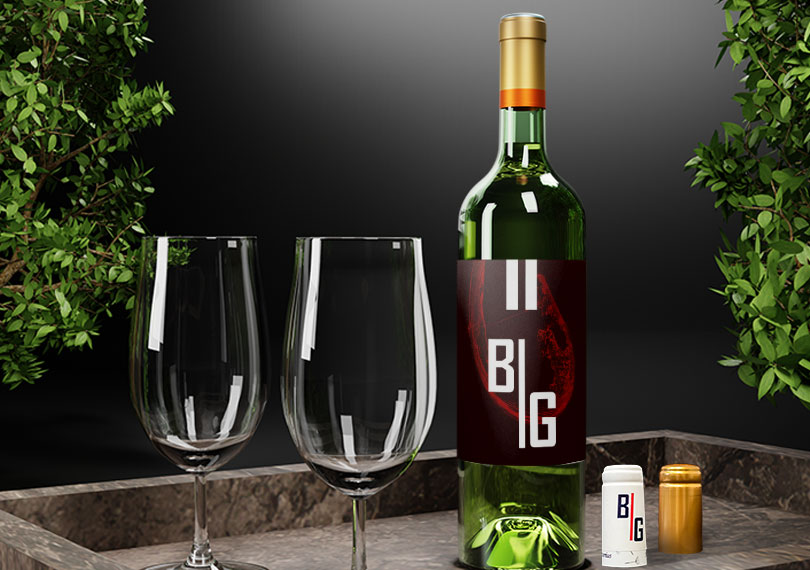
In the packaging world, not only functionality but also first impressions count. Shrink caps perfectly illustrate a solution that combines both aspects. On one hand, they protect the cork and bottle neck, and on the other hand, they provide the product with an elegant and professional appearance. This article explores shrink caps in detail – their structure, usage, application techniques, and the benefits they offer your brand.
What are shrink caps?
Shrink caps are thin sleeves made from plastic, which shrink under heat to perfectly fit the bottle neck and cork. Their purpose is:
- Protecting the cork from dirt and moisture
- Protecting the product against tampering
- Enhancing the aesthetic appeal of the packaging
Shrink caps are most commonly used in the alcohol and food industries—anywhere appearance, freshness, and product safety matter.
Materials used for shrink caps
Various plastics are used to produce shrink caps:
- PVC (Polyvinyl chloride) – the most popular, affordable, flexible, and easy to process.
- PET and PETG – more ecological options, resistant to mechanical damage, commonly used for premium products.
Each material has different properties, making the choice dependent on bottle type, product kind, and aesthetic expectations.
Main benefits of shrink caps
🎯 High-level aesthetics
Shrink caps provide products with an elegant, professional look. They are available in various colors and finishes – matte, glossy, transparent, and metallic. They can also be customized – by adding logos, graphics, vintage markings, or perforations for easier opening.
🔒 Protection and safety
Shrink caps act as a barrier against contaminants, dust, and moisture. They also serve as security seals – an intact cap indicates that the bottle hasn’t been previously opened, increasing consumer trust.
🧲 Product and brand identification
Thanks to customization, shrink caps carry the brand image. Customers instantly recognize the product’s origin and quality when reaching for it.
🛠️ Easy application
The application process for shrink caps is quick and straightforward – all you need is a heat gun or thermal tunnel. Suitable for both manual and machine application.
Shrink cap application process
The application process is simple, fast, and can be performed manually or automatically, depending on the production scale.
🔧 Step 1: Cap placement
The cap is placed on the bottle neck so that it completely covers the cork and sufficient neck area. In smaller plants, this is done manually, while mass production uses automated dispensers integrated into bottling lines.
🔥 Step 2: Heating
After placement, the cap is exposed to heat. Several methods can be used:
- Heat gun – primarily for small batches or individually packaged premium products
- Thermal tunnel – automated equipment using controlled-temperature hot air to evenly shrink caps
- Steam shrink tunnel – for caps made from delicate materials (e.g., PET), where gentle shrinking is required
⏱️ Step 3: Shrinking and adjustment
Under high temperature, the material shrinks and perfectly adheres to the bottle neck and cork surface. Even shrinkage is crucial – overly intense or uneven heating can cause wrinkles or cracks.
🔍 Step 4: Quality control
After shrinking, the product undergoes quality control, examining visual fit, absence of air bubbles, stretching, or uneven shrinking. Industrial production often uses vision systems that automatically detect application errors.
✅ Final effect
The aesthetically fitted, smooth cap adheres to the bottle, protects the cork, and looks elegant. The entire process—from placement to cooling—takes only seconds, achieving premium packaging effects.
🛠️ Integration into production lines
Shrink cap application systems are easily adaptable to existing bottling lines, requiring minimal investment. The technology features high efficiency and low operating costs.
Where are shrink caps used?
- Wineries and distilleries – protecting corks in wines, tinctures, and liqueurs
- Food industry – for products like olive oils, balsamic vinegars, natural juices
Eco-friendly shrink caps
Yes! More companies choose eco-friendly alternatives:
- Caps from recyclable PET and PETG
- Use of recycled materials
This allows high-quality packaging with reduced environmental impact.
Trends and innovations in shrink caps
The packaging market evolves dynamically, and shrink caps keep pace, becoming not just protective elements but also marketing tools, information carriers, and indicators of eco-friendly brand attitudes. Current dominant trends include:
1. Personalization
Flexographic printing enables individually printed cap series—vintage names, limited graphics, or dedications—popular in gift sectors, craft wines, and premium brands.
2. Ecology and sustainability
Consumers increasingly consider environmental issues, prompting responses such as recyclable materials, biodegradable options, eco-friendly inks, and natural finishes.
3. Security technology
Innovations include micro-perforations, holograms, QR codes, and hidden UV identification elements.
4. Information carriers
Caps now carry product details, QR codes linking to online content, and usage instructions.
5. Premium aesthetics and special effects
Designers frequently use gold and silver foiling, “soft touch” effects, metallic finishes, and transparent areas.
6. Integration with other packaging elements
Modern caps often match labels or other packaging elements for visual coherence.
7. Automation and quality control
Technological advancements include vision systems, automated defect detection, and error recognition for color and print.
Shrink caps as brand-building elements
Shrink caps significantly influence purchasing decisions, building trust and customer loyalty through consistent and professional packaging.
Need shrink caps?
B-G offers classic, transparent, colorful, and personalized shrink caps. We’ll advise on the best solution tailored to your product and production line.